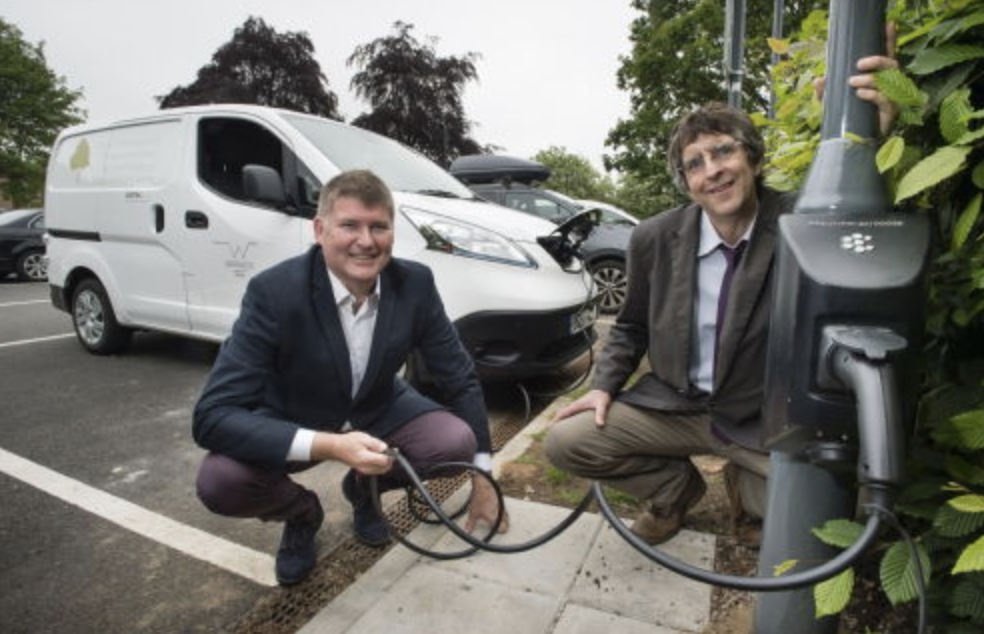Thank you to WMG for sharing this fantastic case study. You can see the rest of their success stories here.
WMG’s investigations helped electric vehicle charging point company, Char.gy, get their product market ready. Now, are on track to install 1,150 on-street EV charge points by 2020, with 300 already in place.
Business: Char.gy
Background
Richard Stobart was an avid EV owner and advocate, but was frustrated by the lack of charging solutions for drivers without access to off-street parking. Spotting a gap in the market, he founded the company Char.gy, and his idea was to install charging units in existing street furniture, for example lampposts.
For this to work, he would need to adapt off-the-shelf components that could be fitted into a small box attached to a lamppost. The unit had to feature warning lights displayed on the outside of the casing. The lights were a requirement of certification, so were essential before the product could go to market.
In addition to this, there were other qualities such as the impact of the device on the structural integrity of the lamppost and it’s positioning on the pavement. They also needed ways to reach more clients to take on Char.gy points and roll them out nationwide.
Richard reflected: “We had created an initial design, but sought some prototyping support from WMG’s SME Group to create the warning lights component, which was needed for certification. This relatively small project has led to an ongoing relationship with WMG to help us further our technology.”
Solution: Energising the product
Our WMG SME Team’s Dr David Norman who specialises in electronic prototyping quickly understood Char.gy’s dilemma and, through a short collaborative project, were able to develop a bespoke electronic circuit that met the dimensions of the lamppost-mounted unit and allowed it to feature the safety lights.
In response to other enquiries from Richard and the Char.gy team, we then put them in touch with Professor Richard McMahon, Professor of Power Electronics at WMG, who provided advice and expertise on fitting the charging points in the real world.
Using our extensive network of UK SMEs, we connected Char.gy with an academic, Yojendra Joshi, Technology Transfer Engineer at WMG, to look into how fitting the box to the lamppost might affect the column itself. They created numerous simulations to observe the effect of the charging ‘backpack’ on the lamppost.
Richard said: “We had to be sure that mounting the box on the lamp column wouldn’t affect its structural integrity, leading to safety problems for motorists or pedestrians. WMG investigated this for us, and the report showed that the mounting holes didn’t affect the strength or safety of the lamppost at all.”

Impact: The future of fuel
Char.gy successfully secured a contract under Transport for London’s (TfL’s) Go Ultra Low City Scheme. They were successfully selected as one of TfL’s eight EV charging providers. Char.gy are on track to install 1,150 on-street EV charge points by 2020, with 300 already in place.
We introduced Richard to the University’s Estates Management team who, seeing the huge value of the solution, installed four of the charging points on campus. Not only this, but we introduced Char.gy to our partners at Coventry City Council who are now using Char.gy units all around Coventry.
Richard McMahon, commented: “The best part of this story is the connections that were made from one department or business to another. WMG cultivates lots of useful relationships and we were really pleased with what they did for us”.
Char.gy are now looking into making the charging wireless, and were recently awarded £2.3m by Innovate UK to test wireless charging solutions for cars on residential roads in selected areas of the UK. A feasibility study was carried out and WMG and Char.gy worked together to plan where the product could evolve to in the future. They are now onto the next stages of strategic planning. The full Innovate UK-funded project, which involves WMG, Milton Keynes Council, London Borough of Redbridge, Buckinghamshire County Council, and Open University, will further develop wireless charging for the real world using specially modified demonstrator vehicles and prototype charging pads embedded in the road.
Richard Stobart said: “Working with the SME Group at WMG opened up the relationship with Prof McMahon and the Power Electronics team. This meant when we saw the opportunity for wireless charging, we were positioned well to seize this by carrying out the feasibility study and forming a consortium for the full-scale project.
“Before we did the initial project, I thought universities were inaccessible to SMEs like us, but after the initial engagement with the SME Group, it has led to more exciting projects and opportunities.”
To hear more about Char.gy please visit their website: https://char.gy/















